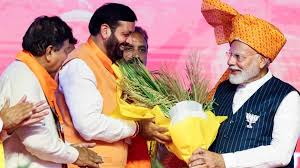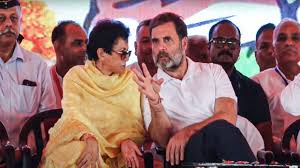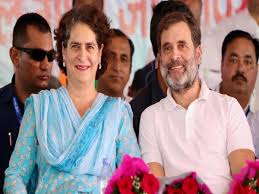BJP’s farewell in Haryana, Saffron party’s humiliation in J&K
 NEW DELHI : If most of the media reports are to be believed, then a Congress tsunami is being witnessed in Haryana. There is a possibility of getting a huge mandate by winning more than three-fourths of the seats in the assembly elections.
NEW DELHI : If most of the media reports are to be believed, then a Congress tsunami is being witnessed in Haryana. There is a possibility of getting a huge mandate by winning more than three-fourths of the seats in the assembly elections.
If this proves to be true, then Rahul Gandhi’s political status will also be strengthened along with the India Alliance at the center. The opposition will try to target the Narendra Modi government at the center by becoming more aggressive. The effect of this change can be seen in the Delhi assembly elections to be held next year as well as the Maharashtra assembly elections.
After the exit poll results, the BJP has come into a defensive position. However, refuting the pre-poll predictions, it kept presenting lame arguments of forming the government for the third time in the state. While most of the Haryana exit polls were predicting a landslide victory for the Congress, the BJP, which was hoping for a hat-trick, was not ready to listen to the anti-incumbency wave that had emerged after 10 years. If the pre-poll estimates are to be believed, the saffron party seems to be out of power. Apart from the BJP and the Congress, the Aam Aadmi Party (AAP), Jannayak Janata Party (JJP) and the Indian National Lok Dal (INLD) also have a stake in today’s election.
Their errors may have been exposed in recent elections, but the exit poll results generate a lot of interest before the actual result day. Most of the exit polls have predicted a clear majority for the Congress in Haryana. Dainik Bhaskar has predicted 44-54 seats for the Congress, 15-29 seats for the BJP, 1-5 seats for the INLD+ and 0-1 seats for the JJP+. The People’s Pulse exit poll has projected Congress to win 49-55 seats in Haryana, while BJP will get 26-32 seats. In Jammu and Kashmir, the prediction says NC will win 33-35 seats, while Congress will win 23-27 seats. BJP will win 13-15 seats, while PDP will win 7-11 seats. The majority mark in Jammu and Kashmir is 46.
Former chief minister Bhupinder Singh Hooda is considered to be the top contender for the top post. Senior party leaders Kumari Selja and Randeep Surjewala are also in the fray despite not contesting the election. The party has refrained from declaring a chief ministerial face for the Haryana elections.
It is mainly a bipolar contest in Haryana. Congress is buoyed by the hope of a comeback after being in the opposition for ten years. In the Lok Sabha elections, Congress had won five seats in Haryana, which it believes puts it in a strong position to form the government in the state this time. In the 2019 assembly elections, the BJP had won 40 of the 90 seats in the state, the Congress 31 and the Jannayak Janata Party (JJP) 10. The BJP had formed the government with the support of the JJP and Dushyant Chautala became the deputy chief minister. The alliance ended after the BJP replaced Manohar Lal Khattar with Nayab Singh Saini as chief minister in March.
Jammu and Kashmir also has 90 seats and voted in its first assembly elections since 2014. The first as a Union Territory and after the removal of Article 370 that granted special status to the then state. Statehood has been a major issue in the elections. Another major player is Mehbooba Mufti’s People’s Democratic Party (PDP) and other parties include Abdul Ghani Lone’s People’s Conference, Ghulam Nabi Azad’s Democratic Progressive Azad Party and Altaf Bukhari’s Apni Party. An interesting development in these elections was the entry of the banned Jamaat-e-Islami, which supported some candidates and forged a strategic alliance with Engineer Rashid’s Awami Ittehad Party. Exit polls in Jammu and Kashmir are predicting a hung assembly. However, this will be known only after the election results on October 8.
Most experts of Haryana politics are unanimous that JJP is not going to win a single seat this time, including Dushyant’s seat. The reason for this is the feeling of betrayal by them among the farmers who voted for them last time. Similarly, Abhay Chautala’s Indian National Lok Dal (INLD) is also not doing well. It is expected to get only one to three seats this time. This means that more than 25 percent of Haryana’s population which includes Jats is united in favor of the Congress party, apart from Jat Sikhs and other farming communities. Does the anti-incumbency wave and the unity of Jats ensure that Congress is winning? This is not entirely true. So the Congress leadership ensured that Kumari Selja, the Congress’s tallest SC leader from the numerically dominant Chamar caste, shared the stage with Bhupinder Hooda.
Bhupinder Hooda and his son Deepender Singh Hooda, who are considered the state’s chief ministerial faces, both got a bigger share in the ticket allocation, which angered rival Kumari Selja and All India Congress Committee (AICC) general secretary Randeep Surjewala. Surjewala remained busy campaigning for his son Aditya Surjewala, who is contesting from his father’s seat Kaithal, while Selja refused to campaign until recently. Significantly, Selja did not hold a single rally until Rahul Gandhi joined the Haryana election campaign. She kept making public statements about her ambition to become the chief minister. This gave a tough fight to the BJP.
This gave the BJP a readymade material. The saffron party kept accusing Hooda of being casteist and not giving space to a Dalit leader in the party. It was only after Gandhi’s first rally in Assandh, the constituency of Shamsher Gogi, a loyal MLA of Selja, that he started his regular campaign. The symbolic handshake by Selja and Bhupinder Hooda on stage at Gandhi’s behest largely allayed fears of a split in the Congress. Another important difference in the speeches of Bhupinder Hooda and other Congress leaders this time was the regular mention of 36 biradaris or all castes to allay fears of an anti-Jat mobilisation.
But the most talked about story in this election is that of ‘Kisan-Jawan-Samvidhan’ (Farmer-Army-Constitution), which includes farmers’ resentment over the BJP’s attitude towards the farmers’ agitation, anger of the youth against the Agniveer scheme and fear among Dalits about abolition of reservation and changes in the Constitution. However, another important issue is that of the Parivar Pehchan Patra, which was launched in 2020 as the Parivar Pehchan Patra Yojana to ease the delivery of services. The process of getting it made put the common man to extraordinary difficulties. The registration process was so complicated that there were many anomalies in it and then the common man had to face a lot of trouble to get them corrected. There was anger among the people against that process as well.
How realistic is such a possibility in Haryana, where just a few months ago, the ruling Bharatiya Janata Party (BJP) got 46.11% of the votes and won half the seats in this Lok Sabha election? Let’s take a look at three key factors that will determine whether this can happen or not. The JJP fought the 2019 assembly elections entirely on an anti-BJP plank, winning ten seats by cutting Jat votes from the Congress. However, it later supported the same BJP in exchange for the post of deputy chief minister and some ministerial posts and also criticised the farmers’ agitation against the three farm laws, which the farmers of Haryana consider unforgivable. Dharam Singh says at a tea stall in Uchana Kalan assembly constituency, “Dushyant, now he will try to enter the village. He will definitely get the punishment for the betrayal.” Dushyant is the sitting MLA and JJP candidate from this constituency.

